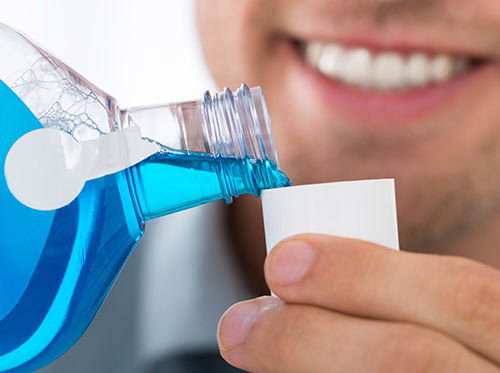October 24th, 2017

Some people choose bottled water over tap because they think it’s cleaner. Some do it out of convenience: It’s easy to grab a bottle of water to take with you for the day as you run out the door or hop in your car.
Whatever the reason, bottled water has been coming in ahead of tap water for the last couple of years. What many people may not know is that choosing bottled water over tap can actually be detrimental to your dental health.
Most brands of bottled water fail to include a vital ingredient: fluoride. Fluoride plays an important role in helping maintain good oral health because it helps strengthen our teeth. Stronger teeth mean a lower chance of tooth decay, and who doesn’t want that?
When we choose bottled water over tap water, we deprive our pearly whites of something they might very well need.
The good news is that the American Dental Association has endorsed both community water fluoridation and products that contain fluoride as a safe way to prevent tooth decay. If bottled water happens to be the preference for you or your family, you don’t necessarily have to force everyone to start drinking tap water.
Just check the label and make sure the brand you purchase contains fluoride.
It’s essential to remember that switching up the water you drink isn’t going to put you on the fast track to perfect teeth, though. Flossing and brushing three times a day is vital!
If you have any questions about fluoride or your dental health, don’t hesitate to ask Dr. Douglas and Larry Harte at our Sparta or Livingston, NJ office!
October 17th, 2017

A solid oral health routine begins with daily brushing, flossing, and rinsing. Without a consistent oral health regimen, you may begin to experience tooth decay and bacterial infections. Few patients ask Dr. Douglas and Larry Harte about different mouthwash options, so we’ve put together a list of the conditions that mouthwashes can treat. This should help you decide which oral rinse would be best for you.
Gum Health
Antiseptic mouthwashes reduce large amounts of bacteria on and near the gum line and generally help to decrease your chances of developing gingivitis. The key ingredients of antiseptic mouthwashes are antibacterial and antimicrobial items. Antiseptic mouthwash is a preferable option if you are concerned about the general gum health of your mouth.
Fluoride
Fluoride is a great tool for preventive tooth decay treatment. It prevents tooth decay and is great for oral health in general because it kills germs that can live in your mouth. Fluoride also builds stronger teeth. If you’re a bottled water drinker, Dr. Douglas and Larry Harte may recommend that you purchase a simple fluoride rinse to use after brushing.
Bad Breath
Fluoride mouthwash can be used to fight any bad breath issues you may be facing. It’s designed to combat any bacteria that might be building up in your mouth. Most mouthwashes will help eliminate bad breath, but some are specifically designed to address this difficult problem. If you feel as though this might be turning into a chronic problem, please contact Dr. Douglas and Larry Harte to discuss other options that would be effective for treating your symptoms.
American Dental Association (ADA Approval)
The ADA reviews all mouth rinses for safety measures and to prove effectiveness. Any mouthwash approved by the ADA has met strict guidelines according to whether the manufacturer’s claims are supported with scientific evidence. If you’re looking for a quality mouthwash, look for one that has the ADA seal of approval to ensure you have a great rinse for your mouth.
Considerations
When you’re trying to decide which mouthwash to pick, contact our Sparta or Livingston, NJ or ask Dr. Douglas and Larry Harte during your next appointment. If you experience a burning sensation in the soft tissues of your mouth, be sure to discontinue use immediately. Avoid letting children under age six use a mouth rinse, and be sure to keep all mouthwashes out of the reach of children, because they contain alcohol and other substances that could be harmful.
October 10th, 2017

There are so many adults and teens in our Sparta or Livingston, NJ office who would love to have their teeth straightened but that are unwilling to go through the long and unsightly process of traditional metal braces. Well, that's where Invisalign® and Invisalign Teen® come to the rescue; the most advanced clear aligner systems in the world!
There are several reasons why, if you're considering getting braces, you should consider Invisalign too. Here are some of them:
- You can eat whatever food you'd like, without worrying about it getting caught in wires or breaking brackets.
- Most people won't even know you're wearing them!
- If you need to, you can remove your aligners at any time.
- The removable aligners let you brush and floss as you normally would, making for better overall oral health.
- Since they are made of a smooth BPA-free plastic, Invisalign aligners are simply more comfortable to wear than traditional braces. No metal means no more roughed up gums or irritated tongue!
- You'll need to visit our Sparta or Livingston, NJ office less often — only once every six weeks or so.
- With Invisalign Teen, you’ll receive up to six replacements for lost or broken aligners.
Before you get started with treatment, you’ll have a consultation with Dr. Douglas and Larry Harte to see if Invisalign or Invisalign Teen is right for you. If your case is a good fit, then you’ll have X-rays, pictures, and impressions of your teeth taken. That information will be used to make the 3D models of your teeth that let Dr. Douglas and Larry Harte see how they will move throughout the entire treatment and approximately how long it will take.
After that, you’ll receive your aligners based on the treatment plan we recommend. You’ll get a new set of aligners every two weeks. Then all you need to do is wear your aligners 22 hours a day and you’ll be on your way to a straighter healthier smile. Don’t hesitate to a member of our Sparta or Livingston, NJ team for more information about Invisalign!
October 3rd, 2017

The iTero® Intraoral Scanner has revolutionized the way orthodontic impressions are taken. Now there's no need for messy, uncomfortable molds. Getting high-quality and accurate impressions has never been easier or more reliable.
When a patient comes to our Sparta or Livingston, NJ office for a consultation, Dr. Douglas and Larry Harte will need to take records of the person’s teeth and bite. Having a replica of a patient’s teeth and bite enables the orthodontist to plan out and visualize the most effective and timely treatment plan.
Traditionally, this was achieved by creating a plaster mold or cast. Putting the impression material and trays onto the teeth can be an uncomfortable process for many patients, especially those who have a sensitive gag reflex.
All that is history with iTero digital impressions. Our patients and team members alike love the speed and accuracy of the iTero Intraoral Scanner. We simply move the wand around your teeth and gums, and within seconds, you get a high-quality, accurate, and color digital impression. That’s all there is to it!
Here’s what patients love about iTero:
- There are no messy and gag-inducing molds involved.
- It’s quick, so the process doesn’t interfere with your busy schedule.
- It’s painless and can be used on even the most pain-sensitive patients.
- Impressions are saved in a digital format, so there’s no risk of molds breaking or needing to be recast.
- Cutting-edge accuracy makes for more timely, comfortable, and effective orthodontic treatment.
Our Sparta or Livingston, NJ office is equipped with the latest iTero technology to make your office visit a breeze. So many aspects of our lives have been digitized and simplified, why should your orthodontic treatment be any different?
If you’re thinking about getting braces or clear aligners, iTero will optimize the experience and help ensure you get the best treatment you possibly can!






